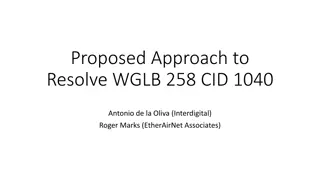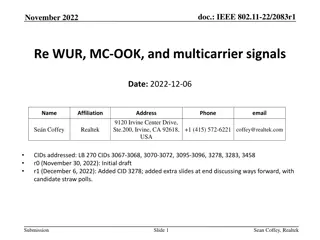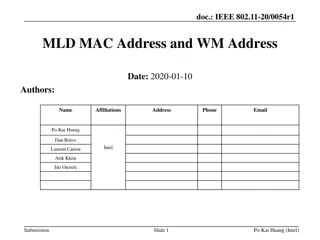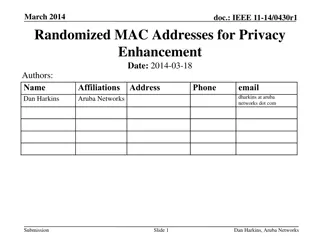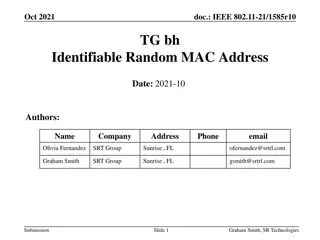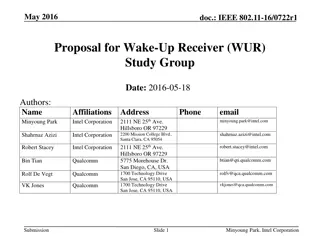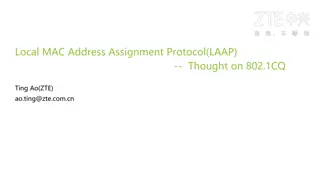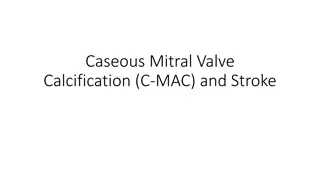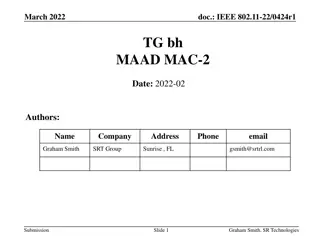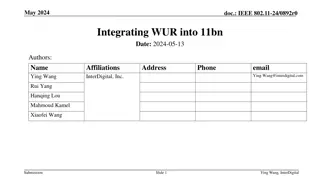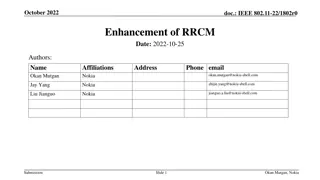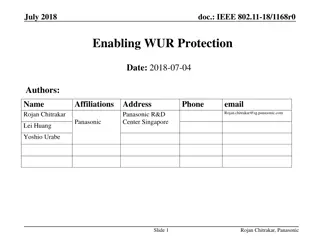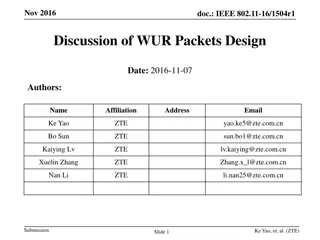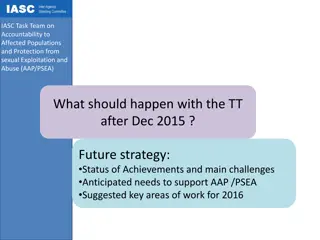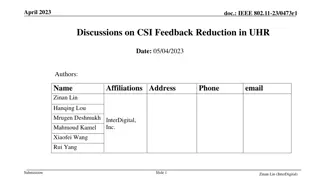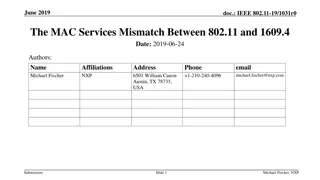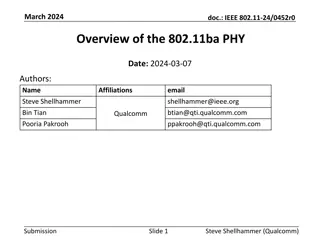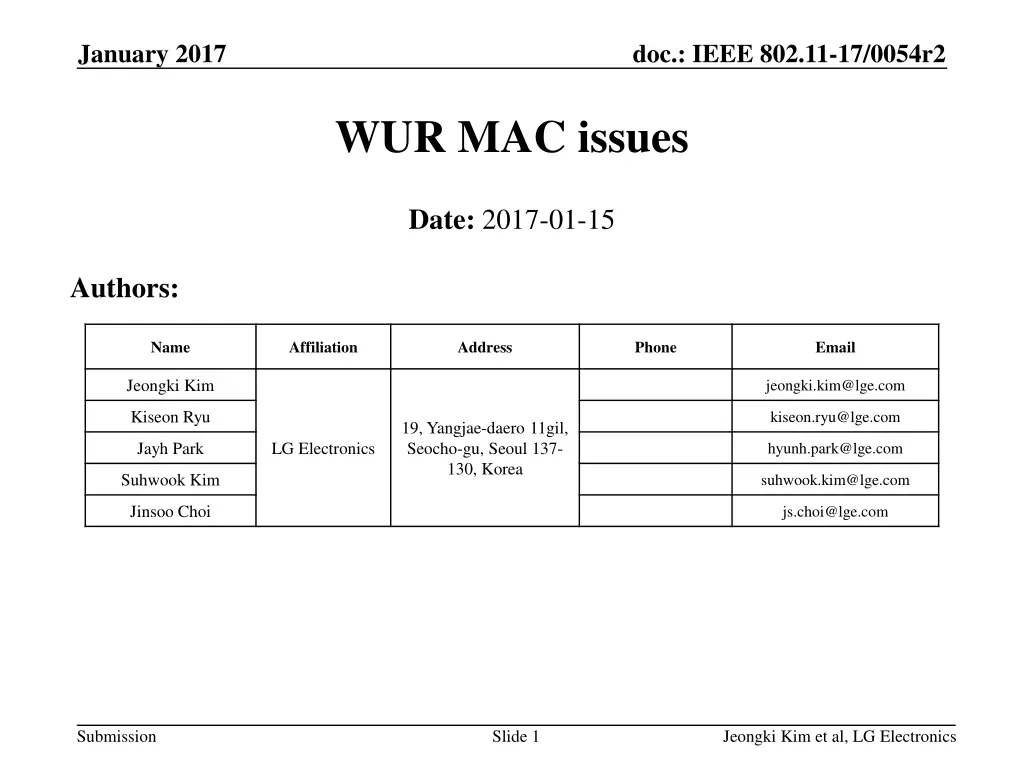
Understanding WUR MAC Issues in IEEE 802.11-17/0054r2 Document
Explore the January 2017 document discussing MAC procedure, Broadcast Wake-up, Group Wake-up, and Multi-User Wake-up issues related to WUR in IEEE 802.11 standards. Delve into the details of Broadcast and Group Wake-up procedures along with Wake-up Completion Time considerations.
Download Presentation

Please find below an Image/Link to download the presentation.
The content on the website is provided AS IS for your information and personal use only. It may not be sold, licensed, or shared on other websites without obtaining consent from the author. If you encounter any issues during the download, it is possible that the publisher has removed the file from their server.
You are allowed to download the files provided on this website for personal or commercial use, subject to the condition that they are used lawfully. All files are the property of their respective owners.
The content on the website is provided AS IS for your information and personal use only. It may not be sold, licensed, or shared on other websites without obtaining consent from the author.
E N D
Presentation Transcript
January 2017 doc.: IEEE 802.11-17/0054r2 WUR MAC issues Date: 2017-01-15 Authors: Name Affiliation Address Phone Email Jeongki Kim jeongki.kim@lge.com Kiseon Ryu kiseon.ryu@lge.com 19, Yangjae-daero 11gil, Seocho-gu, Seoul 137- 130, Korea Jayh Park LG Electronics hyunh.park@lge.com Suhwook Kim suhwook.kim@lge.com Jinsoo Choi js.choi@lge.com Submission Slide 1 Jeongki Kim et al, LG Electronics
January 2017 doc.: IEEE 802.11-17/0054r2 Abstract The overall MAC procedure for WUR was introduced at the last meeting [1] This discusses the details of some WUR MAC issues Broadcast Wake-up Group Wake-up and Multi-User Wake-up WUP (Wake Up Packet) contents design Submission Slide 2 Jeongki Kim et al, LG Electronics
January 2017 doc.: IEEE 802.11-17/0054r2 Broadcast Wake-up (1/2) Broadcast WUP can be sent before sending group address BU To wake up all WUR mode STAs In legacy WLAN, group addressed BU is generally sent after DTIM Broadcast WUP should be sent early with enough time for WUR mode STAs to receive DTIM/GA BU correctly after its wake up delay because Broadcast WUP TX can be delayed if channel is busy Each STA s wake up delay could be different according to each STA capability or environment (e.g., temperature, humidity, etc.) Broadcast Wakeup Group DTIM AP addressed BU Wakeup delay Waiting time STA1 WLAN on STA2 WLAN on STA3 WLAN on STA4 WLAN on Submission Slide 3 Jeongki Kim et al, LG Electronics
January 2017 doc.: IEEE 802.11-17/0054r2 Broadcast Wake-up (2/2) AP (or WUR Transmitter) includes Wake up Completion Time (WCT) in Broadcast WUP WCT: Indicates the time which WUR mode STA should finish its wake up procedure (e.g., TBTT or Group addressed BU TX start time) Each WUR mode STA decides its WLAN-On start time based on the received WCT value and its wake up delay Broadcast Wakeup (WCT) Group DTIM AP addressed BU Wake up start time of STA 1, 2 Wakeup delay STA1 WLAN on WLAN on STA2 STA3 WLAN on Wake up start time of STA 3, 4 STA4 WLAN on Submission Slide 4 Jeongki Kim et al, LG Electronics
January 2017 doc.: IEEE 802.11-17/0054r2 Group wake up and MU wake up (1/2) Group wake up Group wake up can be used for waking up all STAs belonging to a group E.g., Group ID or multicast address May not be efficient if it is used for waking up a part of STAs in a group WUP (GID =1) MU PPDU (STA 1, 2, 3) AP Wakeup delay PS- Polls from STA 1~5 STA1 STA2 STA3 WLAN on Unnecessary power consumption STA4 Unnecessary power consumption STA5 STA1, 2, 3, 4, 5 belong to Group 1 (GID=1) Submission Slide 5 Jeongki Kim et al, LG Electronics
January 2017 doc.: IEEE 802.11-17/0054r2 Group wake up and MU wake up (2/2) 1) WUR ID can be allocated when entering WUR mode Multi-User (MU) wake up WUR need to support MU wake-up mode for waking up a part of STAs in a group Example 1) WUP may contain multiple receiver IDs the WU packet size is increased according to the number of STAs Example 2) WUP may contain TIM TIM size should be optimized (e.g., like 11ah hierarchical TIM, using WUR ID1) instead of AID) WUP (TIM :STA 1, 2, 3) MU PPDU (STA 1, 2, 3) AP Wakeup delay PS- Polls from STA 1~3 STA1 STA2 WLAN on STA3 STA4 STA5 Submission Slide 6 Jeongki Kim et al, LG Electronics
January 2017 doc.: IEEE 802.11-17/0054r2 Wakeup Packet contents design (1/3) Considerations on Wakeup Packet (WUP) design WUP TX frequency as small as possible to minimize the contention with other WLANs/WUPs Broadcast/Group/MU wake up WUP content size should be minimized (e.g., if OOK is used, 1 symbol (4us) is used for delivering 1 bit) WUP optimization Avoid unnecessary false alarm of wake-up MU wake-up Including WUR operation mode (WOM) information which indicates whether the STA wakes up after receiving the WUP or not WUP may be sent for just keep alive check or synchronization In this case STA does not need to wake up Submission Slide 7 Jeongki Kim et al, LG Electronics
January 2017 doc.: IEEE 802.11-17/0054r2 Wakeup Packet contents design (2/3) Option 1 L-Part (e.g., L- STF/LTF/SIG) WUR Preamble (e.g., sequence) WUP contents Transmitter ID (e.g., BSS Color) Receiver ID (e.g., AID) WOM Other information (optional) Transmitter ID (e.g., BSS Color or BSSID) Receiver ID (e.g., AID) Individual ID, Broadcast ID, Group ID, TIM indication (Special value) WUR ID can be used to identify a WUR mode STA instead of AID e.g., WUR ID is allocated when entering WUR mode WOM(WUR Operation Mode): 0- No wake-up, 1-Wake-up Other information can be present optionally E.g., TIM Submission Slide 8 Jeongki Kim et al, LG Electronics
January 2017 doc.: IEEE 802.11-17/0054r2 Wakeup Packet contents design (3/3) Option 2 L-Part (e.g., L- STF/LTF/SIG) WUR Preamble (e.g., sequence) WUP contents Frame Type Receiver ID (optional) Transmitter ID WOM1) Other information (optional) 1) WOM can be delivered implicitly (e.g., by Frame Type) Frame Type 0: Broadcast wake-up 1: Individual wake-up, Individual ID is included as receiver ID 2: Group wake-up, Group ID is included as receiver ID 3: MU wake-up, TIM or multiple IDs set are included FT=0 Transmitter ID WOM Other information (optional) FT=1 Transmitter ID Individual ID WOM Other information (optional) Not including receiver ID Group ID FT=2 Transmitter ID WOM Other information (optional) FT=3 Transmitter ID WOM TIM Other information (optional) Submission Slide 9 Jeongki Kim et al, LG Electronics
January 2017 doc.: IEEE 802.11-17/0054r2 Conclusion To avoid inefficient WUR packet transmission, WUR needs to consider Broadcast/Group/Multi-user wake- up In this case, need to minimize power consumption of WUR mode STAs by avoiding false alarm of wake-up (MU wake-up) Need to consider the followings in WU packet design Less frequent WUR packet TXs Optimized WUR packet Less false alarm WUR operation mode (Wake-up or No wake-up) indication Submission Slide 10 Jeongki Kim et al, LG Electronics
January 2017 doc.: IEEE 802.11-17/0054r2 References [1]11-16/1445r1, Overall MAC Procedure for WUR [2]11-16/0036r2, WUR Frame Structure Submission Slide 11 Jeongki Kim et al, LG Electronics
January 2017 doc.: IEEE 802.11-17/0054r2 Straw Poll 1 Do you agree that the wake-up packet to wake up all WUR mode STAs need to be considered in 11ba TG? Result: Y/N/A: 24/1/12 Submission Slide 12 Jeongki Kim et al, LG Electronics
January 2017 doc.: IEEE 802.11-17/0054r2 Straw Poll 2 Do you agree that multicast wake-up need to be considered in 11ba TG? Result: Y/N/A: 23/3/10. Submission Slide 13 Jeongki Kim et al, LG Electronics
January 2017 doc.: IEEE 802.11-17/0054r2 Motion 1 Move to add to SFD 802.11ba spec shall define a mechanism to wake up all WUR mode STAs (i.e., broadcast wake-up frame) Mover: Jeongki Kim Second: Jinsoo Choi Submission Slide 14 Jeongki Kim et al, LG Electronics
January 2017 doc.: IEEE 802.11-17/0054r2 Motion 2 Move to adopt the following to SFD 802.11ba spec shall define a mechanism to wake up multiple WUR mode STAs (e.g., multi-user wake-up frame) Mover: Jeongki Kim Second: Jinsoo Choi Submission Slide 15 Jeongki Kim et al, LG Electronics

